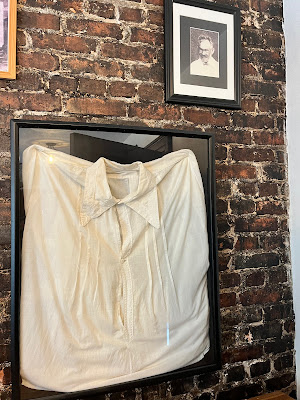First Congregation Sons of Israel
St. Augustine, Fl
April 7, 2022
Description:
First Congregation Sons of Israel is the oldest Synagogue in “The Nation’s Oldest City”, St. Augustine, Florida and is located in the beautiful historic district. They are a conservative, egalitarian congregation had hold weekly Sabbath services. The Synagogue suffered from Hurricane Matthew which caused extensive damages to the Sanctuary. Many people got together and gave generous donations to help with the repairs which lead to the reopening in 2018. The strong community that surrounds the Synagogue came together in order for the final restorations to be completed.
Exterior 1
Exterior 2
Artifact 1
This mural, is made by stained glass. It just so happens to be the stained glass from the original set of stained glass windows they received. There was a box filled with the glass and they used that to make this beautiful mural around the Star of David.
Artifact 2
This artifact is is the original kittel (prayer robe) worn by the first rabbi of the 1st Congregation Sons of Israel. The rabbi's name was Jacob Tarlinsky and he wore this kittel in the 1800s.
In Conversation 1
This stained glass mural is located in the Roman Catholic Church my parents attend. The church is called St. Thomas The Apostle Church in Bloomfield, New Jersey. When I would be sitting in Sunday mass, the stained glass would always catch my attention because there are stories in most of them and I would focus on them to try and figure the story out.
In Conversation 2
This Roman Catholic Church is also the one my parents attend but with an outside view. Out front of the church there is a cross. When going to visit the First Congregation Sons of Israel, I realized that different religions have different symbols that are significant. For the First Congregation Sons of Israel, they have the Star of David while Roman Catholics have the cross.
Literature In Conversation
“Do you not see how the glacier / already floods the streets / of the cities around you?” - Craig Santos Perez, Thirteen Ways of Looking at a Glacier, page 19
When Hurricane Matthew hit St. Augustine, the First Congregation Sons of Israel Synagogue was extremely damaged due to the flooding in the surrounding city. The community needed to come together in order to achieve donation money to donate to help repair the synagogue. The goal was reached and now most of the repairs are completed.
Creative Component
For my creative component portion of this section, I chose to digitally draw the Star of David the is on the ceiling of the Synagogue. A Flagler College student had designed this structure and they took place in setting it up the Star of David.
















































